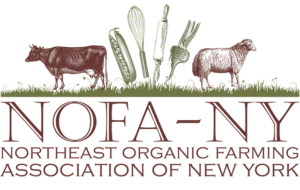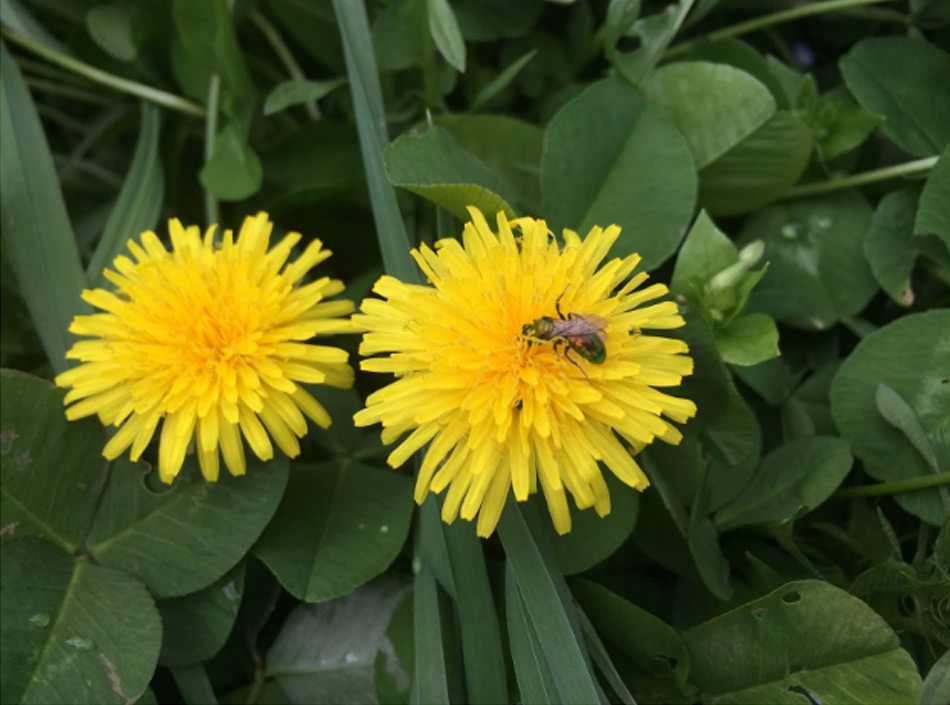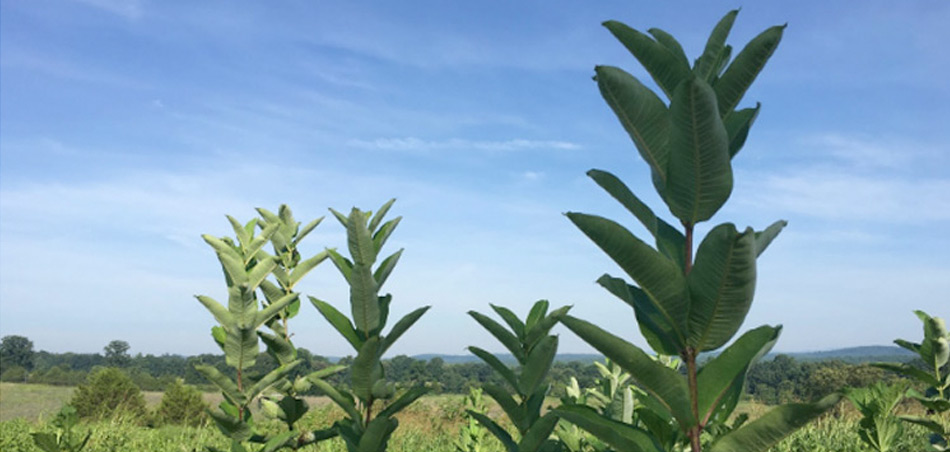I am often asked by my clients what they should be doing NOW to ensure long-term success. At this time of year, I tell them, “Remember that soil microbes need to eat every day, and you’ve got to feed them!” If you were left starving and naked outside all winter, would you be ready to work in the spring? Probably not. Soil microbial life is the same; in order to keep soil vital through the winter rains, freezing temperatures, wind, and whatever other weather might come your way, then cover up your pastures, cropland, lawns and gardens!
Since any system is only as good as its weakest link, anywhere that the cold air, raindrops, and wind can get to your soil without a carbon blanket (a cover of dead or living plant material) is an area where your system will shut down and cause you problems next year. If there are spaces between your plants, I like to think of them as holes in your land’s sweater and rain jacket. Brrrr! Even between your cover crop plants, you want that soil covered! Once you get effective rotations of crops and cover crops, plant residues aka “litter” from the previous crop will ensure that you have no bare soil.
Luckily, fall, winter, and early spring are the best times to build your soil.
Usually, we have good moisture in the winter. It’s not so dry as in the heat of summer, and you can build soil structure rapidly – especially if you have living roots and covered soil. Microbes are active even under the snow, especially if there is enough “litter” or plant matter covering the soil surface for them to eat. Cover crops are the best option for soil cover because they provide both carbon cover, living roots AND sugars to feed soil microbes directly. That means more soil structure and organic matter being built all winter so you have more water- and nutrient-holding capacity next spring.
In case you are new to cover cropping or need a basic refresher, this practice (sometimes known as growing “green manure”) uses winter-hardy plants that will be grazed, stomped, rolled, or cut down in the spring to loosen and aerate the soil. Although it is sometimes advised, I’ve found that it is not generally helpful to till them in to kill them in the spring, as that disturbs soil fungal networks. Of course, there are a few occasions where doing so might be warranted as a stop-gap on your way to a management approach that relies less on harmful disturbance. One example of when you may need to till the cover crops to kill them is when nutrient cycling is really shut down, and you need the tillage to break down the residues, such as when transitioning heavily tilled and/or chemically laden soil.
The Benefits of Cover Crops
When you plant cover crops in fall, you will:
- Protect the soil from compaction, erosion, wind, freezing and nutrient loss due to hard winter rains
- Suppress and reduce weeds during the winter, as well as next growing season if the residues are left on top of the soil
- Maintain and enhance soil structure
- Build organic matter and keep nutrients cycling in the soil
- Enhance microbial diversity, numbers and activity
- Save you $$$, labor and time! Planting into soft, fluffy soil is much easier than planting into compacted chunks, plus it takes less weeding, watering, and inputs
The Best Time To Plant Fall Cover Crops
To accomplish these goals, you’ll want to get the cover crop sown at least 6 weeks before first frost date. Usually, for spring grazing and planting, you don’t want to seed too early and have the plants flower before frost and snow, as they won’t come back in the spring. Depending on your growing zone, that generally means that ideally, cover crops should be planted before the end of September to mid-October; you want them rooted and well established before the weather gets too nasty. Sometimes you can get lucky if you are planting late, and will get a successful crop, but the risk increases and benefits usually decrease after this planting window.
How to Choose & Plant the Right Cover Crop Mixture
When choosing a cover crop mixture, consider that cover crop species and functional groups are best used in combination. If you plant them together, aim to plant a nitrogen-fixing legume with a tall crop for structural support, or use a pre-combined mix suitable for your situation. Use taprooted crops to help break compaction (but know that some of these are best planted earlier in late summer, so they develop a taproot before the frost and that taproot dies off and feeds sugars to earthworms and provides holes for water infiltration over the winter!). 8-12 species mixtures are great, but you must make sure you can kill them at the right time for your spring planting and not have to use tillage or herbicides.
Below are a few easy to seed, cost-effective, simple mixes that will work well in the American northeast for fall seeding and rolling for an easy kill without herbicides.
Winter Cereal Rye (NOT annual ryegrass) and Austrian Winter Pea (a nitrogen fixing legume that flowers at the same time as the cereal rye). These can be mixed 64 lb per acre drilled rate; increase the rate for broadcast seeding and poorer soil conditions. They can be mixed into the same no-till drill compartment, or for small applications mixed in a bucket and thrown out together. The seeds need soil contact, and ideally plant them at a depth of ½” – ¾” into the soil for best germination. If you are hand seeding them, rake in and cover with mulch. You need to get them as deep as you can if you don’t have a drill… and add more to the seed rate to compensate for attrition.
If you want to get planting earlier (about 2 weeks earlier, in fact), try Crimson Clover at 12 lbs / A (it shouldn’t spread like other clovers as long as it’s rolled down before viable seed is formed) and Barley (a winter hardy cereal grain) at 76 lbs / A . This mix is a little trickier because ideally you would plant with a technique called “alternate row” seeding. When no-till drilled, put the barley in the grain box and the clover in the legume box, but cover alternate openings with cardboard and tape so that you seed one row of barley and the next of clover. If you are at home, it’s too laborious to hand plant individual rows, so mix them and do the best you can!
How and When to Kill the Cover Crop
One reason I recommend these 2 simple mixtures is because they are both easy to kill without tillage or herbicides. If you don’t have a roller – you can use a long wooden board and stomp it down (hint: tie a rope on either end and walk on it), a mower drug across with the blades turned off, or a barrel with a little water rolled across it. The pea will vine up the rye and help to kill it come spring without herbicides or tillage. Sometimes the peas grow back up a bit after rolling, but don’t worry about this as the heat kills them.
Pro tip: These peas are great for eating as fresh salad greens all winter, and the sweet shoots are delicious in stir fries or raw. Their flowers are incredible and look like orchids!)
You want to roll or knock it down until at LEAST 30% of the rye and pea are in flower stage. Once it starts growing in the spring, this can happen quickly as they develop fast. For a visual of what it looks like when ready to roll down, watch the following video. It is the same garden from the first video in this blog post – about a month later!
A continuous-cover, no-till, living root 24-7 system is the best to give your microbes food, shelter and warmth to increase their number of days they are actively working for you. Cropping in a no-till organic system, without herbicides or tillage, requires thinking and planning ahead; it can get complex to choose an approach that meets your current and future needs. When deciding which of the many cover crop options to use (as well as when deciding whether or not you need to seed a cover and where to seed them), it is important to KNOW YOUR WHY. I always recommend getting help from an experienced mentor to help you decide which cover crops are best for your unique situation.
 See our Pro Tips blog entry on the Northeast Organic Farming Association of New York (NOFA-NY), which focuses on inoculants, to learn more about making the most of this important practice and this vital time of year.
See our Pro Tips blog entry on the Northeast Organic Farming Association of New York (NOFA-NY), which focuses on inoculants, to learn more about making the most of this important practice and this vital time of year.
JOIN US! Vail will be presenting more great information at NOFA-NY’s 2018 Winter Conference January 19-21, 2018 in Saratoga Springs, NY.
Share On

